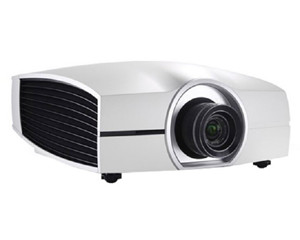At Infocomm 2015, Barco was mostly talking about applications, laser retrofit solutions and a new interactive screen solution.
The interactive solution features three projectors blended on a curved rear-projection screen. It has an IR camera mounted in the rear that can sense when a finger touches the screen as the reflected light changes at that point. Positional software then calculates the location of the touch on the screen and initiates any actions resulting from the position. The system can support an unlimited number of touch points which means 2-3 people can easily be working side by side on the system simultaneously – all interacting with content.
Barco offers a full suite of software for interacting with content in a number of different modes. This is conveyed in a kind of hub and spoke diagrammatic fashion. Lots of content can be connected to or be accessed by the system and it can even read QR codes with the IR cameras so users can log in and out of the system by placing their badge on the screen for reading. Barco is targeting this for high level collaborative environments. No pricing was announced but you can bet it won’t be inexpensive.
Barco is also offering a laser-phosphor retrofit solution for its cinema-class projectors. This is being marketed to theater exhibitors as well as the ProAV market.
The idea is to replace the Xenon lamp and housing with a solid state light engine that consists of a laser-phosphor wheel and blue lasers that sit inside the projector, with an external chiller for the cooling the blue lasers and DMDs. For non-DCI compliant applications like museums, auditoriums and maybe rental and staging, the internal media block is also removed. These non-DCI and DCI-compliant applications share the same chassis, power supplies and electronics, so the retrofit serves both markets. Projectors with 2K or 4K imagers are supported.
Other companies, like Cinemeccanica, are also offering to retro fit Barco projectors RGB lasers and others will pop up soon. But Barco warns about these retrofit solutions. They note that the light load on the DMD and optical elements changes when moving to laser phosphor or RGB laser solutions, so any replacement solution must account for this, so be sure to enquire carefully. (there was more on the issue of retrofits at Display Summit – Panel on Digital Cinema (DS16))
At CinemaCon 2015, Barco showed the first retrofit solution and they showed it again at Infocomm in a private meeting room. The solution can support a projector that can output 20K lumens (good enough for a 45 foot screen), but at Infocomm, only 12K lumens was shown as the screen size was rather small. Even so, the image was much brighter than would be shown in a real cinema and the colors had not been calibrated either. The demo featured a 2K imager and the light source can reach the needed P3 color gamut but with reduced optical efficiency (i.e. much lower lumens).
The company was also showcasing their laser-phosphor standalone projector with 6000 lumens, the PGWU-62L, which we first saw at NAB. It is offered with WXGA or WUXGA resolution (exact pixel count not specified).
 Barco PGWU 62L
Barco PGWU 62L
Just after Infocomm, Barco introduced a new cinema projector at CineEurope. The DP2K-6E is said to be the smallest and quietest cinema projector in the Barco portfolio and can support screens up to 24 feet wide (7.5 m). It comes with an optional ceiling mount and runs on two UHP lamps that are easy to swap. Control is via the Barco Commander software for local access or via the Barco Web Commander software for remote access.
The DP2K-6E includes the Barco Alchemy technology that combines media server functionalities, Series 3 cinema processing electronics, and on-board storage. The projector gathers all required functionalities in one turnkey unit, enabling small screen commercial exhibitors and independent cinemas to benefit from top-notch digital cinema image quality in a budget-friendly way.
The DP2K-6E will be available in October 2015.

